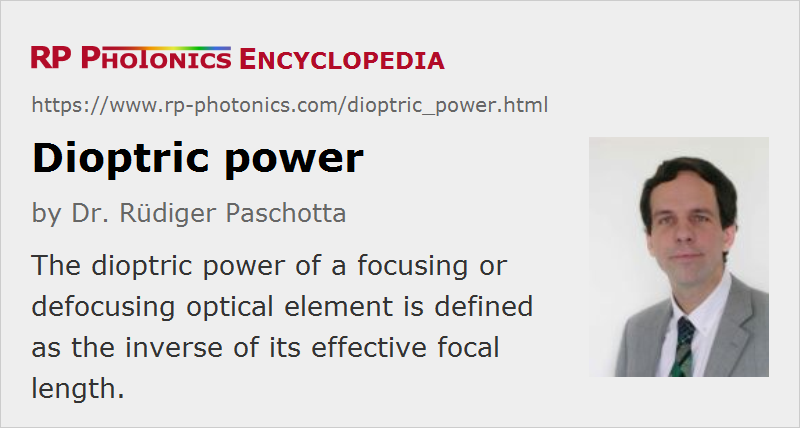Dioptric Power
Definition: the inverse of the focal length
Alternative terms: power, focusing power
German: Brechkraft, Brechwert
Formula symbol: ϕ
Units: m−1
How to cite the article; suggest additional literature
Author: Dr. Rüdiger Paschotta
The dioptric power of a focusing or defocusing optical element is defined as the inverse of its effective focal length. Sometimes it is just called power, but this is ambiguous because power occurs with various different meanings, e.g. magnification or optical power.
The dioptric power is measured in units of m−1, also called diopters (dpt). It is common to specify the dioptric power of prescription glasses, for example, whereas the focal length is usually specified for standard lenses, microscope objectives, and photographic objectives.
In many cases, the dioptric power is a more natural quantity than the focal length, because stronger focusing action implies a higher dioptric power but a longer focal length. For example, the dioptric power of the thermal lens in a laser crystal is proportional to the dissipated power. The width of the stability zones of a laser resonator with respect to dioptric power of the thermal lens depends only on the minimum mode radius in the laser crystal and on the optical wavelength, whereas the stability range in terms of focal length has a more complicated dependence.
Some additional aspects come into play when the medium before and after the optical system is not the same. For example, we may consider an underwater camera, where the object side is filled with water, while the interior of the camera is filled with air. In that situation, the front focal length of the camera objective is larger than the back focal length. The dioptric power must be calculated from the effective focal lengths, which is related to the case n = 1. One thus takes the inverse of the back focal length, which is the same as the refractive index of water divided by the front focal length.
The dioptric power of a single interface between two media is the difference of refractive index divided by the radius of curvature of the surface.
The combination of two thin lenses at a close distance has a dioptric power which is simply the sum of the powers of the two lenses. If the distance d is not negligible, the total dioptric power is:
Questions and Comments from Users
Here you can submit questions and comments. As far as they get accepted by the author, they will appear above this paragraph together with the author’s answer. The author will decide on acceptance based on certain criteria. Essentially, the issue must be of sufficiently broad interest.
Please do not enter personal data here; we would otherwise delete it soon. (See also our privacy declaration.) If you wish to receive personal feedback or consultancy from the author, please contact him e.g. via e-mail.
By submitting the information, you give your consent to the potential publication of your inputs on our website according to our rules. (If you later retract your consent, we will delete those inputs.) As your inputs are first reviewed by the author, they may be published with some delay.
See also: focal length
and other articles in the category general optics
 |




If you like this page, please share the link with your friends and colleagues, e.g. via social media:
These sharing buttons are implemented in a privacy-friendly way!